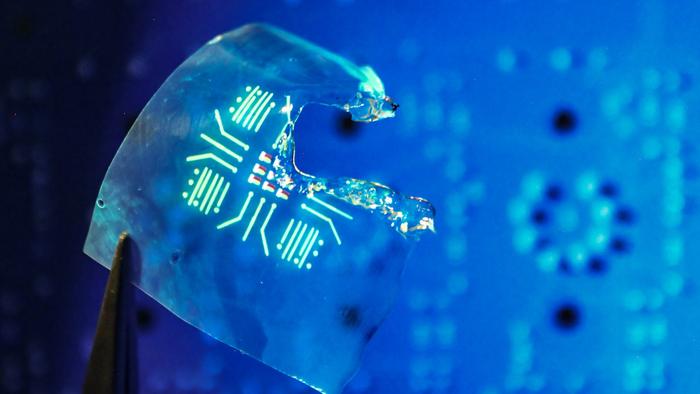From your car’s navigation display to the screen you are reading this on, luminescent polymers — a class of flexible materials that contain light-emitting molecules — are used in a variety of today’s electronics. Luminescent polymers stand out for their light-emitting capability, coupled with their remarkable flexibility and stretchability, showcasing vast potential across diverse fields of application.

Credit: (Image by Jie Xu and Yukun Wu.)
From your car’s navigation display to the screen you are reading this on, luminescent polymers — a class of flexible materials that contain light-emitting molecules — are used in a variety of today’s electronics. Luminescent polymers stand out for their light-emitting capability, coupled with their remarkable flexibility and stretchability, showcasing vast potential across diverse fields of application.
However, once these electronics reach their end use, they are discarded, piling up in landfills or buried underground. Recycling this electronic waste is complex, requiring expensive and energy-inefficient processes. Although there is an economic incentive to recycle the key semiconducting materials — in this case, luminescent polymers — there has been no method to achieve this due to the challenge of designing those materials at the molecular level.
“We were able to make this material biodegradable and recyclable without sacrificing the functionality.” — Jie Xu, Argonne scientist who led the project
Overcoming this challenge was the motivation behind the newest Nature Sustainability publication led by researchers at the U.S. Department of Energy’s (DOE) Argonne National Laboratory, along with collaborators at the University of Chicago, Purdue University and Yale University. The team developed a strategy to design luminescent polymers with high light-emitting efficiencies from the start that are both biodegradable and recyclable. They do so by incorporating a chemical called tert-butyl ester into the luminescent polymers which can break down when exposed to heat or mild acid.
In short, this chemical enables the recycling of the material while maintaining high light-emitting functions.
The team then used a device to test the material’s external quantum efficiency, an indicator of light source performance. It scored an impressive 15.1% in electroluminescence, a tenfold increase from the existing degradable luminescent polymers.
At the end of life, this new polymer can be degraded under either mild acidic conditions (near the pH of stomach acid) or relatively low heat treatment (> 410 F). The resulting materials can be isolated and remade into new materials for future applications.
“We were able to make this material biodegradable and recyclable without sacrificing the functionality,” said project lead Jie Xu, a scientist in the Center for Nanoscale Materials, a DOE Office of Science user facility at Argonne. “This work serves as an important benchmark in addressing the urgent need for sustainability in the design of future electronics.”
The team aims to make future electronics more sustainable (easier to degrade or recycle) and not just design for current function. They also want to expand the usability of these products into other fields.
“Design is still compatible with processibility and in the end, you have to use this in real applications,” said Yuepeng Zhang, a materials scientist at Argonne and publication co-author. The researchers predict this new polymer can be applied to existing technologies, such as displays and medical imaging, and enable new applications.
Next steps for scaling the technology include moving it from the lab to electronics such as cell phones and computer screens with continued testing.
The team noted this is only a first step in the process, but with electronic waste, every step counts. Xu hopes that more attention will be paid to designing electronics with recyclability in mind, especially since this depolymerization proof of concept was so successful.
“This is a $46 billion-a-year industry, and it is only growing,” said Xu. “By 2032 the industry is estimated to grow to $260 billion. With this method, we can eliminate this type of electronic waste that would otherwise be piling up in landfills.”
Additional Argonne authors include Wei Liu, Aikaterini Vriza, Hyocheol Jung, Shiyu Hu, Benjamin T. Diroll, Richard D. Schaller and Henry Chan. Other authors include Yukun Wu and Sihong Wang (Argonne, Purdue University), Cheng Zhang, Glingna Wang (University of Chicago), Du Chen, Peijun Guo (Yale University) and Jianguo Mei (Purdue University).
Funding was provided by an Argonne Laboratory Directed Research and Development award, the National Science Foundation and U.S. Air Force Office of Scientific Research.
About Argonne’s Center for Nanoscale Materials
The Center for Nanoscale Materials is one of the five DOE Nanoscale Science Research Centers, premier national user facilities for interdisciplinary research at the nanoscale supported by the DOE Office of Science. Together the NSRCs comprise a suite of complementary facilities that provide researchers with state-of-the-art capabilities to fabricate, process, characterize and model nanoscale materials, and constitute the largest infrastructure investment of the National Nanotechnology Initiative. The NSRCs are located at DOE’s Argonne, Brookhaven, Lawrence Berkeley, Oak Ridge, Sandia and Los Alamos National Laboratories. For more information about the DOE NSRCs, please visit https://science.osti.gov/User-Facilities/User-Facilities-at-a-Glance.
Argonne National Laboratory seeks solutions to pressing national problems in science and technology by conducting leading-edge basic and applied research in virtually every scientific discipline. Argonne is managed by UChicago Argonne, LLC for the U.S. Department of Energy’s Office of Science.
The U.S. Department of Energy’s Office of Science is the single largest supporter of basic research in the physical sciences in the United States and is working to address some of the most pressing challenges of our time. For more information, visit https://energy.gov/science.
Journal
Nature Sustainability
DOI
10.1038/s41893-024-01373-z
Article Title
Depolymerizable and recyclable luminescent polymers with high light-emitting efficiencies
Article Publication Date
22-Jul-2024




